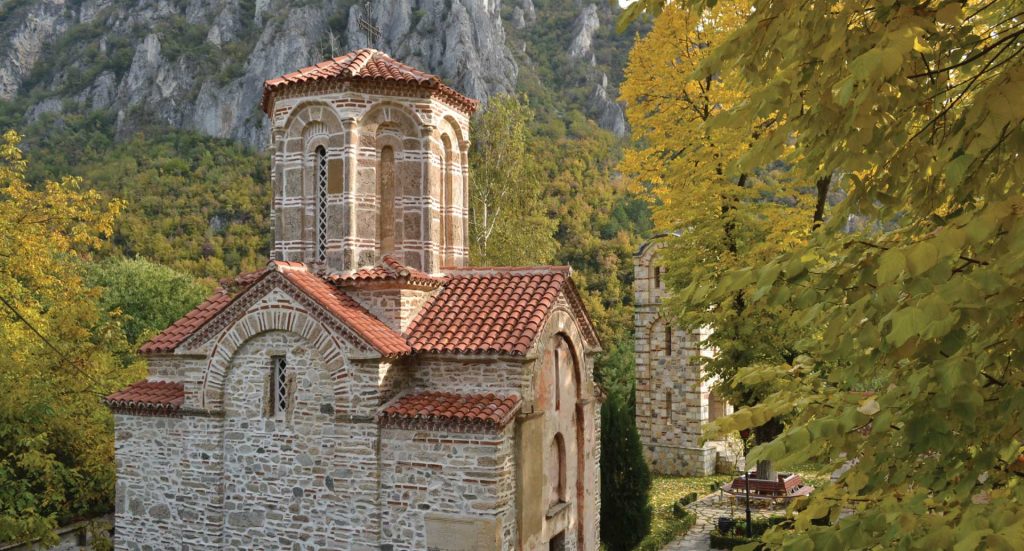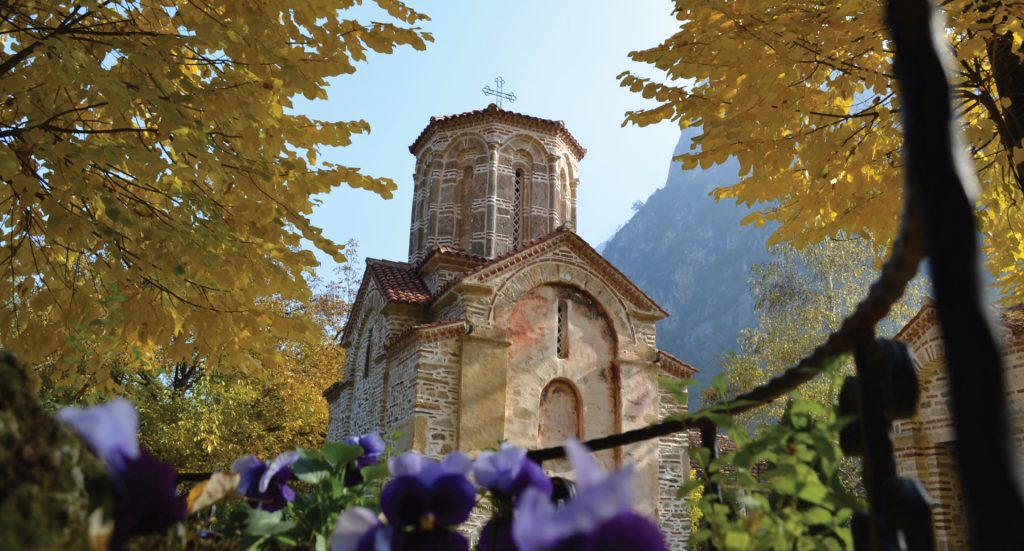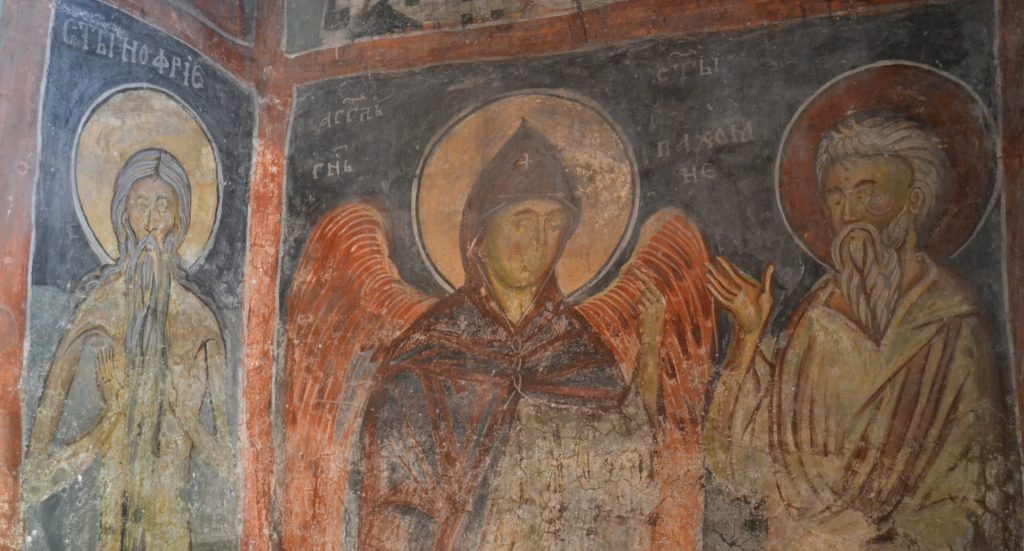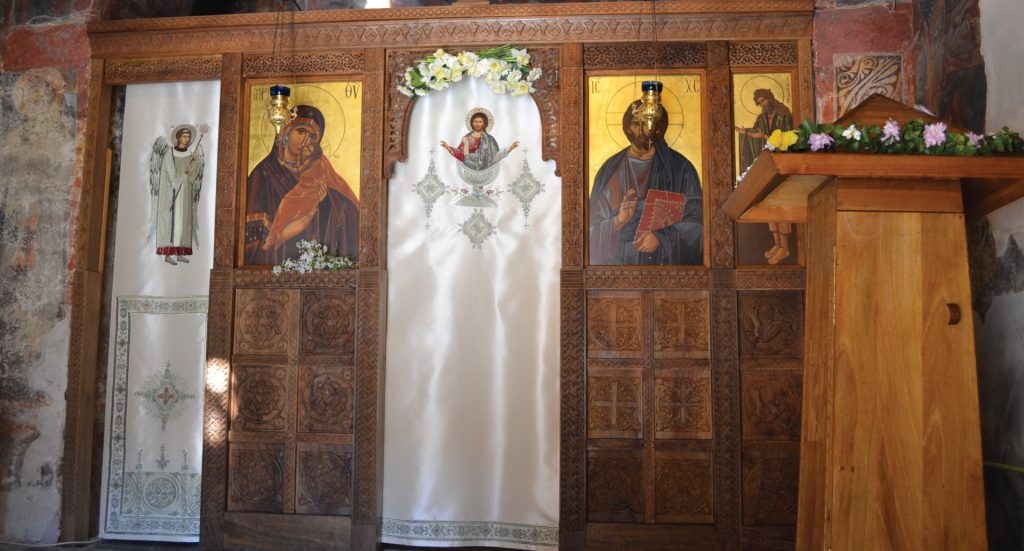The Christian temples from the medieval period of Matka are worthy indicators of the Macedonian medieval history and art, i.e. of the Macedonian spiritual and artistic heritage. They can not be compared to anything man-made, for they transcend everything in every aspect, because they symbolize the Kingdom of heaven here on earth. That is why, very often, builders and painters avoided writing their own names, knowing that it was a work of God, a gift from God, that is, that through their hands God himself created.





Rebuilt around 1337.
From the rocky gorge, today enclosed by a high concrete dam, built in 1938, the river Treska flows towards north for one mile through a very narrow gorge, and then the field expands. Here, around the 14th century, on a broad flattened terrace on the left bank, upon the site of an ancient sanctuary, was erected the Monastery of Matka, with a church dedicated to the Dormiton of the Theotokos.
The exact time of the church’s construction, is not known, nor the first founder. However, several researchers assume that the church was rebuilt around 1337 by Boyko, son of the unknown lady Danica, on the basis of the afore-mentioned inscription in the church of St. Nicholas in Ljuboten which states that in this period Boyko was the master of Matka







Arhitecture.
The design of the church is that of a narrow, indented cross with a dome, supported by a four-wall square base. In the outer wall of the church are embedded stone remains from the early Christian period, also from the basilica above which it is believed the church have been built.
In the search for the exact time of the construction of the original church, we must not ignore the headstone of the Christian Marija, discovered in the church,on the floor before the altar.
“Why wonder, oh people who see me in this grave? Know that, also, you will be too, but, the memories with you are dear, remember me also the servant of God, Marija, but called Velislava. Presented to God on September 28, 1372.”
According to this article, we can only assume that in 1372 when Marija was buried, construction of the church was already completed.








Freskopainting
The roof and frescoes of the original church suffered, probably during the hectic events of establishing the Turkish rule in Macedonia. In the nave of the church, above the west entrance, an inscription is preserved from 1497 and it mentions the name of the founder Milica who repaired the roof of the church, painted the frescoes, and finished the vestibule.
According this article, it is clear that the original construction of the church is from the 14th century, while the roof and frescoes are from the late 15th century.
The additions built by Milica in 1497 are not preserved and it is unknown when they were demolished. Today, over the door of the church, are still visible the remains of the frescoes which were then inside the vestibule
The frescoes in the monastery Matka belong to Ohrid painting school of the late 15th century. Here, for the first time were found frescoes from that school, adapted in the space of a compact type cruciform. The dark burgundy colour dominates the atmosphere, broken with the light chromium oxide green, ocher (pale yellow), olive green and grey.
The painting program was passed on to us completely, by m-r Jehona Spahiu. We are very grateful for her generosity and knowledge.





The hand carvings
The hand-carved iconostasis (work of the former woodcarving workshop Emo-Ohrid) and a single-leaf door (work of Mile Nestor) are prepared and placed for the temple of the Dormition of the Most Holy Theotokos – Matka, in 2000. The carving is a project of Vasil Iliev, who draws all the motives from the low carving of the Slepce school – an authentic stylistic expression in carving in the XIV century, created by the monks of the monastery of St. John the Baptist in Slepce.
The icons on the iconostasis, as well as the drawings for the icons on the single-leaf door, are the work of Malka Koneska.
The pedestal, in carving, for the icon of the Most Holy Theotokos which was part of the old iconostasis, was made in 2019, following the example of the carving of the iconostasis.

The Most Holy Theotokos with Christ, icon - XVIII century.
The icon of the Most Holy Theotokos with Christ, which is part of the iconostasis from the XVIII century, at the request of the believers who have built a prayerful relationship with the Most Holy Theotokos, respecting this icon of hers, was restored, and today is in the church on a special pedestal with low carving .
The icon, according to a report by the Institute for the Protection of Monuments and Culture of the City of Skopje, has little value. Its value for the believers, for all of us, as an icon of the Most Holy Theotokos, the protector of our monastery and the city of Skopje, Macedonia, is enormous.
During his stay in the monastery of the Dormition of the Most Holy Theotokos-Matka, of St. Gavril, the Velichki bishop, his father monk Kiril, after a temptation and prayer in front of the icon, received blessing from the Most Holy Theotokos and saw light from her eyes. There are traces of tears on the icon itself.

























